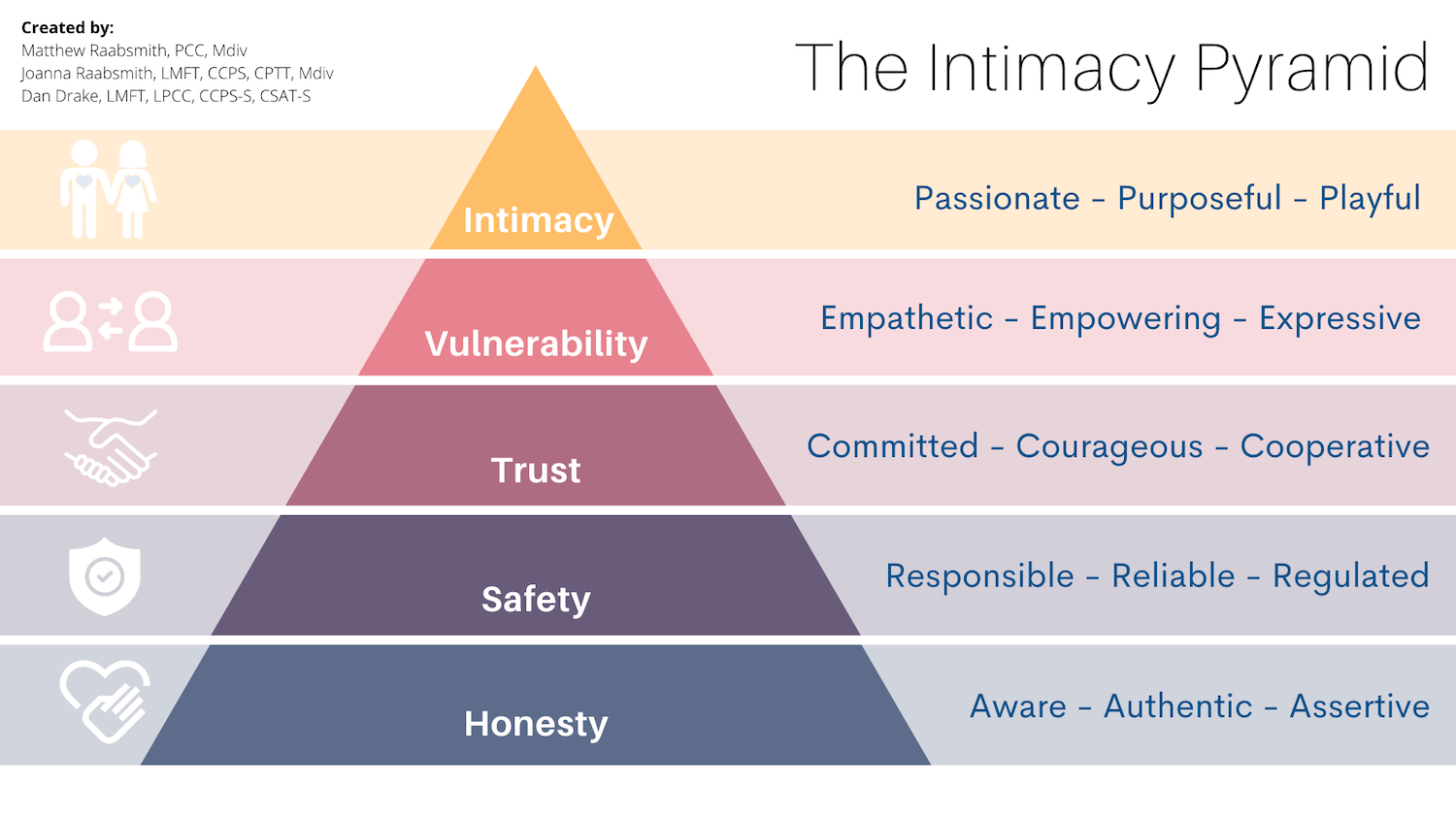In our last post, we explored the foundation of the Intimacy Pyramid: Honesty. We took a look at the damage dishonesty brings, and the healing that honesty creates. Building our relationship on a foundation of honesty is like building a house on rock, not sand.
Honesty allows us a secure base we can build from, which is crucial for healthy intimacy. Yet honesty only establishes the foundation. Let’s now turn to building safety and trust, the next levels of the pyramid.

We define safety as, “a sense of relational security created by ongoing constructive behavior from each participant.” Notice the word behavior in that sentence. Safety is not built back through words. As we talked about previously, sexual betrayal is a betrayal due to lies. So words alone aren’t going to be enough to rebuild safety. Our words need to be followed-up with action over time. This isn’t a one-time thing!
We need to be reliable, and when we mess up we need to promptly admit it. Continued lies erode safety in a relationship, so honesty and integrity are so important to help us repair.
One other note: our definition of safety involves ongoing constructive behavior from each participant. While both people contribute to the safety of the relationship, after betrayal it is the betrayer’s responsibility to initiate the focus on safety. Lies and deception wound the betrayed partner and the relationship. So the betrayer needs to spend focused attention on repairing those wounds by restoring safety.
Safety, as demonstrated through action, helps the betrayed partner see that more often than not, the betrayer is really working on doing what they say they’re doing. Words and actions lining up over time builds trust back after betrayal. And what is trust? We define trust as “a confident conviction that our partner says and does things that are for us and for our relationship.”
Sounds simple enough, right?
Though simple, building back trust takes time and dedicated attention after betrayal. In most of the situations we see, the betrayer’s sexual behaviors were secret and they used lies to cover up those behaviors. So, a betrayed partner needs time and consistent trustworthy actions from the betrayer to help restore trust.
Building back trust requires courage!
The betrayer needs courage to live in the light of honesty not lies, and the betrayed partner needs to be open to seeing the trustworthy acts of the betrayer. But through this courage, we can continue to build a deepened commitment to the relationship, and a renewed focus on building a new relationship that has nothing to hide and nothing to fear.
Ok, so now what? What do we DO to help build safety and trust after betrayal?
One very practical way we build back safety and trust after betrayal is through the betrayed partner setting boundaries, and the betrayer following-through with honoring those boundaries. Something that we want to clarify right away: Boundaries are for safety, NOT for control or punishment. Boundaries come from our core values and needs for internal and relational safety. So, after betrayal, when safety and trust erode, the betrayed partner needs a space to say what things they need that will help keep them safe. Think of the boundaries that the betrayed partner shares as a roadmap towards safety. These boundaries, when honored, will help the partner repair safety internally and relationally.
So boundaries are a gift (even if it doesn’t feel like it!). Think of boundaries as a way the betrayed partner says, “If you do these things I will feel more safety and security in our relationship.” We’d really encourage you to see boundaries this way, rather than seeing them as obligations or as a method of control. Boundaries take the guess work out of rebuilding safety: They’re spelled out by the betrayed partner.
But wait, there’s more!
Not only do boundaries offer a roadmap towards relational safety, boundaries, when honored through action over time help repair trust too. When the betrayer acknowledges the boundaries, commits to honoring them, AND FOLLOWS THROUGH with honoring them over time, they are showing that their words and actions line up. And as we saw before, words lining up with action is a major way that we can repair trust after betrayal.
As you can see, the more we focus on safety in our relationship the more trust gets restored. The more trust we have, the safer our relationship becomes. And as we’ll see in our next post, safety and trust allow for vulnerability in our relationship, which is essential for creating the intimacy in our relationship that we’re all looking for. Stay tuned for more on vulnerability and intimacy.
For more information on the work we do and our new book Building True Intimacy check out www.intimacypyramid.com.


